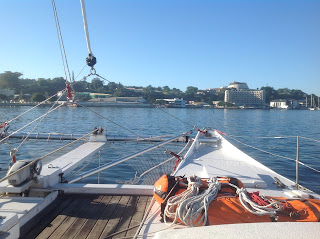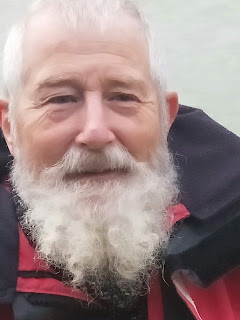After our friends left to fly home to NZ
from Port Vila, Denise and I stocked up with more food supplies, water and
diesel ready to sail further north. Just before we left a large 52 foot
Scottish Wharram Catamaran arrived called Calagorm and we had a great time
meeting up with the owners and seeing their boat. It had many excellent
features and innovations.
We left Port Vila on a sunny day with a
favourable wind forecast. We were unable to visit Port Havannah first as the
area was still closed due to the rhinoceros beetle infestations ashore. Instead
we set sail for Nguna Island but, as often happens, after a good start the wind
swung around and we were beating into winds up to 30 knots to make Matu bay at
the northern end of the island. It was
worth all the effort, a sheltered bay backed by three imposing volcanic cones.
We thankfully relaxed with a cold shandy from our fridge! It had been a hard
hot afternoon’s sail!
Next we skirted Cooks reef as we sailed to
Emae island. Again a bush clad Island
with several small villages scattered around the shores. Beautifully clear water and plenty of
coral.
Arriving in Emae Island
Sunset at Emae Island
We particularly enjoyed our contact with
the villagers at Revolieu Bay and Lamen Bay on the west coast of Epi
Island. We spent 2 glorious weeks on
Epi. The villagers were very welcoming and keen to show us around and share
their culture with us. We spent many happy hours chatting with them. The villagers lead very basic lives and most
lived in thatched huts, but they are very well tended, neat and tidy with well
maintained gardens.
Denise with Chief Baron, Revolieu Bay, Epi
Chief Baron demonstrating use of his tam tam drum to
summon the villagers to a meeting
Outside Chief Baron’s house
Some of the children we played ball with in Revolieu
Bay - they were thrilled to see this photo of them on our iPad
Schooling is available on many of the
islands but not every family can afford to send their children. Every family
has a garden, usually set away from their home, in which they grow vegetables
and fruit, and their diet is supplemented by fish, chicken and other delicacies
like flying foxes (a type of bat). Pigs are slaughtered especially for
important feasts and ceremonies.Together with Ted and Steve, we had purchased
household items, fishing gear, machetes and balls, books and pencils for the
children as we had heard that the villagers in these outer islands were very
poor. We were able to deliver these to
the some of the people of Epi….they were so grateful and it was delightful to
see the pleasure and excitement on their faces.
One of
the villagers in Lamen Bay delighted with her new machetes
This young man was over the moon with his new fishing
lures
A gorgeous little boy in Lamen Bay playing with the
new ball we gave him
We were fortunate at last to spot a Dugong
one day in Lamen Bay although as we were ashore at the time we only managed to
see this strange creature cavorting in the shallows from a distance. We also saw numerous very large turtles.
Lamen Bay was very busy with boats, both
cargo and ferry, coming in each day. The locals buzzed around in their small
fishing boats and some cruised by in their simple outriggers.
Don by our dinghy on the beach at Lamen Bay
A cargo vessel being unloaded with necessary supplies
in Lamen Bay
A local outrigger - lots of these are still in use in Epi
There is no longer a functioning pier in Lamen Bay -
this one was destroyed in an earthquake
There was great excitement one day in the
village. The Prime Minister, the Australian High Commissioner and other
dignitaries were flying in to farewell the Australian forces who had been on
the island for 2 weeks working with and training the local police and forces in
disaster relief procedures. They also signed a memorandum of understanding
committing to more joint ventures.
School children and villagers lined the dirt road in the village and the
guests, local chiefs and other dignitaries were welcomed with a stamping dance
and singing, all very exciting. A small
contingent of the Australian navy had been camped nearby for several days for
the training exercise.
Schoolchildren of Epi lining the street at Lamen Bay
to welcome the Prime Minister and other
dignitaries
A group of locals performing a rousing dance as part
of the welcome ceremony
These lovely ladies spent hours making these leis from
local flowers to present to all the honoured guests - the Prime Minister,
dignitaries and members of the armed forces and police of both Vanuatu and
Australia
The islanders laugh and smile a great deal
and enjoy a good joke, an example of which we experienced at dusk one evening
in Lamen Bay. A coastal supply ship
arrived and much to our alarm appeared to be steaming straight for us where we
were anchored. As I was standing on our
aft deck waving my arms and flashing a light they suddenly came to a halt
behind us and dropped their anchor. I could
hear peels of laughter from their fore deck as they watched my alarm. Apparently they always stopped in that
position to unload into small boats which they proceeded to do.
View from our cockpit of the supply anchoring behind
us - we were enjoying a sundowner drink at the time
The wind has been very strong of late and
we needed to sail south from Epi to Port Vila so that Denise could catch her
plane back to New Zealand on 30 September. At last a very brief weather window
looked promising and we were off at 5 am on 24 September. It was a fairly fast,
if boisterous passage, but an unfavourable wind change later in the day
prevented our arrival in daylight into the harbour, so we hove to until
daylight.
Now we are back on a mooring readying for
the voyage to NZ in October. It is a noisy bustling place Port Vila but we like
it here, and have just come back on board after a great meal ashore with a
bunch of other yachties, including our Calagorm friends whom we also met in
Lamen Bay. Denise flies back to NZ tomorrow (30 Sept) and Ted, the crewman
flies in next week.










































